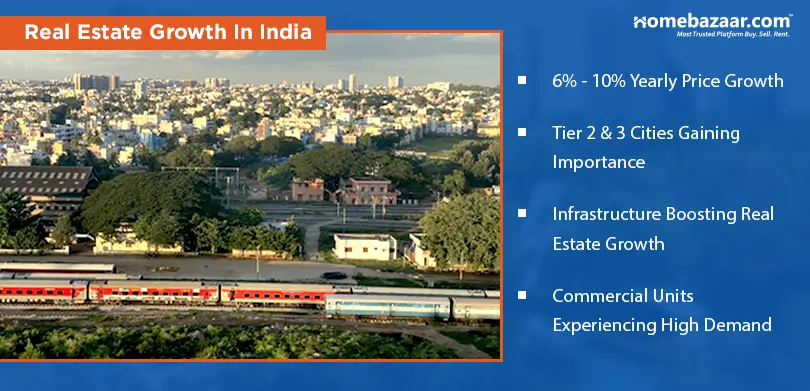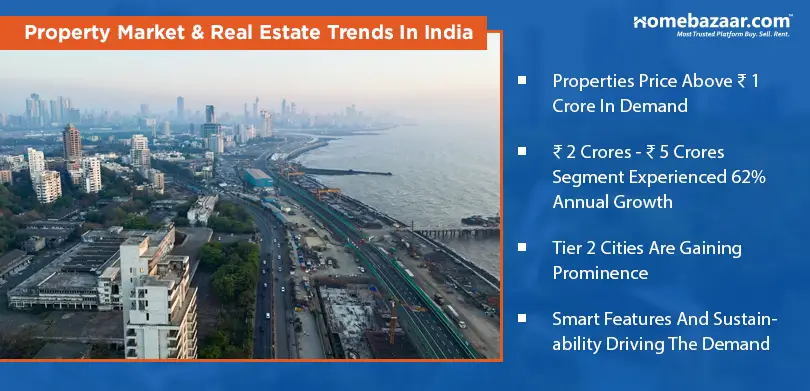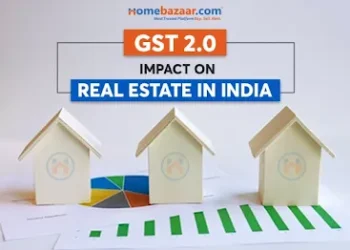1-minute Brief Summary: Real Estate Returns In India
Real estate in India is said to be the most preferred investment option by millennials. Houseownership is a sense of pride and a symbol of status, which is the driving force behind the growth of this sector in India. However, before investing in real estate, it is vital to understand and analyse the returns on investment. The annual returns on investment should not be less than 10%.
Properties in India witnessed around 10% of price appreciation last year. The supply of premium inventory has increased to meet the growing demand for housing. With progressive infrastructure development and rising income levels, people are preferring luxury properties with advanced facilities. Tier 2 cities and peripheral regions are gaining traction as they offer lucrative returns on investment, considering their foreseen development.
The metro cities comprise expensive properties and offer steady growth. Whereas, the peripheral regions of these cities are a good source of investment returns. The promising infrastructure and scope of land availability assure maximum rental yields and resale value.
Real estate in India is one of the most popular and anticipated investment options. As per IBEF, the real estate sector is a significant employment generator and contributes approximately 7% to the country’s GDP. As mentioned in the CRISIL report, this contribution is expected to increase to 15.5% by 2030, with the real estate sector reaching the $1 trillion market.
Read Also: Real Estate Trends and Its Future Predictions
Page Contents
How Is The Real Estate Growth In India?

The real estate sector in India has grown substantially in the last two decades, along with frequent variations. Post the pandemic-led lockdown, the real estate graph in India has been on an upward trend. In the last year, India witnessed a 6% – 10% yearly price growth. This growth can be attributed to the rising demand for premium properties and a resilient economy.
Rapid developments and urbanisation of the outskirts are uplifting the growth trajectory of Indian real estate. Excellent transport infrastructure is one of the key factors determining the demand for property and growth in a city in India. It is expected that 38% of the Indian population will reside in urban centres till 2030, as stated by Cushman and Wakefield.
Backed with progressive urbanisation, Tier 2 and Tier 3 cities are gaining prominence among modern homebuyers. These cities hold great potential for future growth and price appreciation at competitive property prices. Along with the residential sector, the commercial, retail, and hospitality industries are also experiencing substantial growth.
Also read: Luxury Real Estate in Bangalore
What Are The Real Estate Returns In India?

India has a dynamic real estate landscape, spanning across residential, commercial, logistics, industrial, and retail sectors. Property investment in India offers lucrative returns on investment and rental yields. The returns on investment depend on various factors such as the location, regional economic conditions, financial stability, surrounding infrastructure, etc.
Cities and micromarkets with a resilient economy and sound infrastructure tend to attract more demand. These cities ensure maximum returns on investment for the long term. To estimate the average return on investment, one must consider the necessary costs involved in the homebuying and post-homebuying process.
While buying a house, you must take into account the pertaining EMIs and interest till the loan is fully repaid. Before purchasing the property, calculate the yearly returns on investment and confirm whether it is feasible. The yearly return on your property investment should not be 10% or less. Thus, choosing a prime location with smooth connectivity, solid infrastructure, and efficient social facilities is mandatory.
Commercial properties offer more returns on investment than residential properties. Though equity and stock investments provide higher returns, they are prone to market risks and financial losses. Therefore, real estate is a safer investment option that offers steady appreciation.
Also read: Pune Real Estate
Property Market and Real Estate Trends In India

The Indian property market is experiencing an increased demand for mid-segment to premium properties. Affordable housing options priced below ₹ 50 Lakhs witnessed a declining supply. Apart from major cities like Mumbai, Bangalore, Delhi, Pune, and Chennai, many emerging cities are gaining the attention of homebuyers. These cities include Gurugram, Lucknow, Hyderabad, Indore, Nagpur, Navi Mumbai, Noida, etc.
The demand for mid-segment and luxury housing has gone up. Properties ranging over ₹ 1 Crore solely accounted for half of the sales in India, whereas those ranging between ₹ 2 Crores – ₹ 5 Crores experienced 62% annual growth.
Real estate in India maintained its momentum with a 12-year high sales volume, as stated in the Knight Frank India Real Estate Report H2 2024. There was a rise in the leasing volume, with Flexspace contributing to the major growth. The demand for flexspaces has gradually increased in the key markets like Mumbai, Bangalore, and Delhi.
Sustainability and tech-enabled facilities are gaining prominence among homebuyers and developers. Modern homebuyers prefer projects with sustainable features and smart home facilities for additional convenience. Cloud-based building management systems have simplified the maintenance of housing societies.
The demand for office units has risen significantly, specifically in the peripheral and emerging real estate hotspots. Due to the presence of enormous talent, ongoing and proposed developments, and a booming housing market, the peripheral regions account for huge leasing volumes. Similarly, the hospitality and logistics sector will continue to grow owing to lifestyle advancements.
Also read: Mumbai Real Estate
What Is The Real Estate Forecast Next 5 Years?
The real estate landscape has been evolving over the last decade. The change in demographics, homebuyers’ preferences, disposable income, and economic resurgence has transformed the real estate scenario in India. As stated by Savills India, the data centres will have an expansion of around 15-18 million sq. ft. by 2025 end.
Also read: Is Hyderabad A Metropolitan City?








